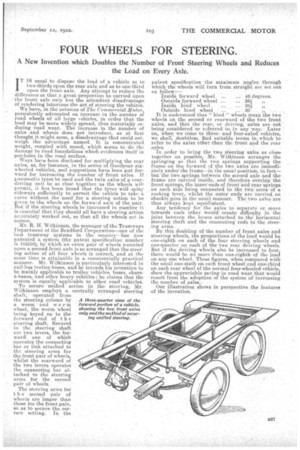FOUR WHEELS FOR STEERING.
Page 11

If you've noticed an error in this article please click here to report it so we can fix it.
A New Invention which Doubles the Number of Front Steering Wheels and Reduces the Load on Every Axle.
IT IS usual to dispose the load of a vehicle as to two-thirds upon the rear axle and as to one-third upon the front axle. Any attempt to reduce the difference so that a great proportion be carried upon the front axle only has the attendant disadvantage of rendering laborious the act of steering the vehicle. We have, in the columns of The Commercial Motor, persistently advocated an increase in the number of
_ road wheels of all large vehicles, in order that the load may be more widely spread, thus materially reducing road wear. The increase in the number of axles and wheels does not introduce, as at first thought it might seem, a disadvantage that could outweigh the advantage named. It is concentrated weight, coupled with speed, which seems to do the damage to road foundations which evidences itself in pot-holes in the road surface. . \Vays have been disclosed for multiplying the rear axles, as, for instance, in the series of Goodyear sixwheeled vehicles, and suggestions have been .put forward for increasing the number of front axles. If pneumatic tyres be used and the twin axles' of a reardriving unit be as close together as the wheels will permit, it has been found that the tyres will splay sideways sufficiently to permit the vehicle to take a curve without the need for a steering action to be given to the wheels on the forward axle of the pair. But if the steering wheels be increased in number it is cesential that they should all have a steering action accurately worked out, so that all the wheels act in unison.
Mr. R. H. Wilkinson, the manager of-the Tramways Department of the Bradford Corporation—one of the Lest tramway systems in the country—has now patented a system (the patent specification number is 183510), by which an extra pair of wheels mounted 'won a second front axle is so arranged that the steering action of all four wheels is correct, and at the same time is attainable in a commercially practical manner. Mr. Wilkinson is particularly interested in rail-less trolley-buses, and he intends his invention to be 'mainly applicable to trolley vehicles, buses, chars8.-bancs, and other heavy vehicles; he claims that the system is equally applicable to other road vehicles.
The steering arms for t Ii e second pair of wheels are longer than those for the front pair, so as to secure the correct setting. In the patent specification the maximum angles through which the wheels will turn from straight are set out as follow:— Inside forward wheel ... 45 degrees.
Outside forward wheel ... ... 36i Inside hindwheel ... 38* „
Outside hind -wheel ... 30 .
It is understood that ." hind." wheels mean the two wheels on the. second or rearward of the two front axles, and that the rear, or driving, axles are not being considered or referred to in any way. Later on, when -we cbme to threeand four-axled vehicles, we shall," doubtless, find suitable terms in which to refer to the axles other than the front and the rear axles.
In order to bring the two steering axles as close together As possible, Mr. Wilkinson arranges the springing so that the two springs supporting the frame on the forward .of the two axles are immediately under the frame—in the usual position, in fact— but the two springs between the second axle and the frame are carried inside, and therefore overlap the front springs, the inner ends of front-8,nd rear springs on each side being connected to the two arms of a rocking lever, whilst the outer ends are carried on shackle pins in the usual manner. The two axles are
thus alivays kept equidistant. .
Any tendency for the axles to separate or move towards each other would -create difficulty in the joint between the levers attached to the horizontal steering shaft and the connecting rods to the steer. ing arms.
By this doubling of the number of front axles and steering wheels, the proportions of the load would be one-eighth on each of the four steering wheels and one-quarter on each of the two rear driving wheels. But if the driving wheels also be increased to four, there would be. no more than one-eighth of the load on any one wheel. These figures, when compared with the usual one-sixth on each front wheel and one-third on each rear wheel of the normal four-wheeled vehicle, show the appreciable saving in road wear that would result from the adoption of the system of increasing the number of axles.,
Our illustration shows in perspective the features of the invention.






























